|
|
|
|
History of Cool Springs
|
| |
|
|
|
|
| |
From the very earliest days, Cool Springs camp and service station was an important stop for motorists traveling Arizona's Route 66. Cool Springs was built in the mid-1920s and has been connected with Route 66 from the very start. The legacy of Cool Springs reflects the larger story of Route 66. The Mother Road gave it life. The hey-day of Route 66 was the hey-day of Cool Springs.
|
|
| |
When Route 66 declined in this area, so too did Cool Springs. Route 66 is the most celebrated of the old US highways, and the Cool Springs area is perhaps the most spectacular and unique stretch of the Mother Road to be found anywhere between Chicago and Santa Monica; a “must-see” for the adventuresome automobile enthusiast or historian. |
|
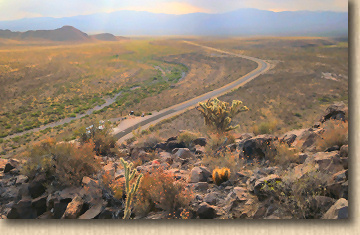
Oatman Road and Cool Springs 2018
|
|
| |
|
|
|
|
| |
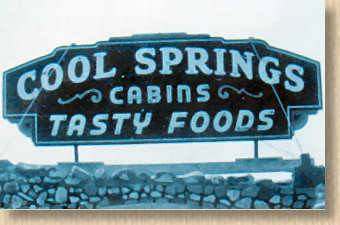
Original Cool Springs Sign
|
|
Cool Springs is on the eastern slope of the Black Mountains, the rugged range along the Colorado River in northwestern Arizona. This is a vast land, wind blasted, and sun scorched. It can be a hostile land. But it is also a land of unparalleled beauty. The old highway leaves Kingman, Arizona going west and crosses the Sacramento Valley. Old Route 66 follows the contours of the land with all its dips and swells. This is flash flood country during the short rainy season. Most of the year though rain is but a hoped for respite. |
|
| |
|
|
|
|
| |
From here Route 66 passes Cool Springs Camp and heads straight into the jaws of the Black Mountains ahead. This route is the original Old Trails Highway that paralleled the Beale military road from 1857, and became Route 66 in 1926. Of all the stretches along Route 66 this was perhaps the most intimidating of all, with its steep grades, narrow road, and hairpin curves. Some travelers of old Route 66 would pay the locals to drive their car up the grade for them or even have their vehicle towed over the summit. |
|
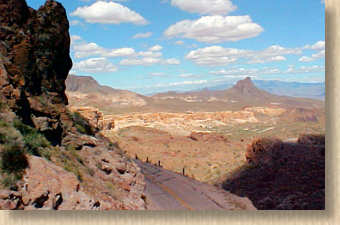
The Gold Hill Road up Sitgreaves Pass
|
|
| |
|
|
|
|
| |
John Steinbeck included a comment on this particular stretch of road in his book, "The Grapes of Wrath". In his book, what was it Pa Joad said about this old road as he looked back at it from the safety of the Colorado River? Didn't he compare those mountains to the bones of a country? This was the Route 66 of the Grapes of Wrath and the Mother Road of Cool Springs.
For early motorists, Cool Springs represented a life-saving stop, to check for oil, water, gas up and maybe grab a bite to eat. |
|
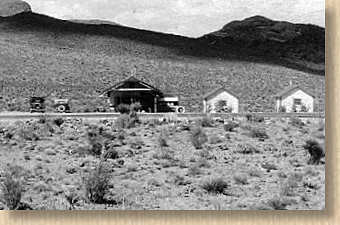
Cool Springs 1926
|
|
| |
|
|
|
|
| |
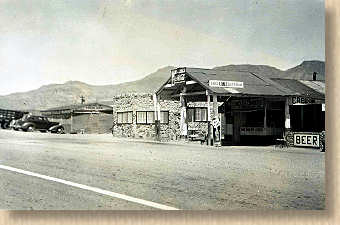
Cool Springs 1936
|
|
In the 1930’s, James Walker moved his family from Huntington, Indiana to live at Cool Springs. While there, Mr. Walker built 8 cabins, improved the station and ran the operation. Mrs. Walker cooked the meals and made sandwiches. The kids, Tom, Mary, Jim and Chuck, all helped out. Mr. Walker returned to the midwest leaving Cool Springs to Mrs Walker. |
|
| |
|
|
|
|
| |
Cool Springs continued to flourish through the World War II years. Mrs. Walker married Floyd Spidell and he continued the tradition at Cool Springs. Their chicken dinners became a mainstay for the Route 66 traveler in western Arizona. After the war America’s love affair with the automobile took off and Cool Springs entered its golden age. |
|
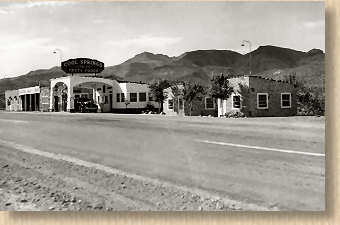
Cool Springs 1942
|
|
| |
|
|
|
|
| |
|
|
|
|
| |
More Americans took to the highways. Some were looking to relocate to California, others took vacations to wondrous new places like the Pacific Ocean, Hollywood and the Grand Canyon. America was on the move once again and Route 66 was the highway of choice, due in part by Nat King Cole's hit song "Get Your Kicks on Route 66", written by Bobby Troop in 1946. Route 66 brought a new wave of travelers through the fabled Southwest and right past the doors of Cool Springs. All this new business had a down side though. As the main route between Chicago and Los Angeles the traffic on Route 66 increased. It became a particularly dangerous road and Sitgreaves Pass a particularly dangerous stretch.
Cool Springs was important at this time because it provided a welcome stop for weary travelers to rest up and check their automobiles before tackling the treacherous Gold Road Hill up to Sitgreaves Pass or to calm their nerves after descending this steep pass. A stop at Cool Springs during those days might just have saved many lives.
Then in the early 1950s something happened that foreshadowed the changes to come for Route 66. This part of Route 66 was bypassed by a new straighter alignment of Route 66 through Yucca, Arizona, that did away with the need to traverse the steep mountain grades of Sitgreaves Pass. Interstate-40 follows this newer alignment of Route 66 across the desert today. This new alignment of Route 66 also bypassed the town of Oatman, Arizona, effectively turning it into a ghost town. After the mines closed during World War II, Route 66 had provided the economic base for the old mining town and the business, like Cool Springs, located along her route. When the newer alignment of Route 66 was opened the busy days of Cool Springs became numbered. |
|
| |
|
|
|
|
| |
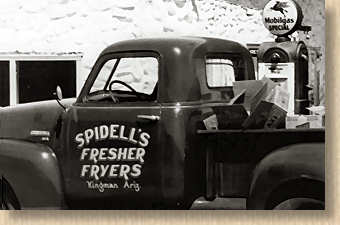
Floyd Spidell's Truck at Cool Springs 1948
|
|
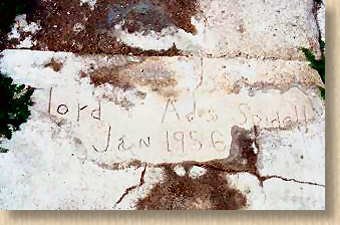
Memories drawn in wet concrete 1956
|
|
| |
|
|
|
|
| |
|
|
|
|
| |
Sometime later, Mrs. Walker left Mr. Spidell leaving Cool Springs to him. With the passage of years an elderly Floyd Spidell found the upkeep of Cool Springs increasingly difficult. He asked his niece, Nancy Schoenerr to come and live at Cool Springs and give him a hand. Nancy and her husband, Chuck, moved to Cool Springs in 1957 with their kids and Aunt Nettie.
The Schoenerr’s serviced cars, sold gas and prepared chicken dinners. By this time the new alignment though Yucca had taken its toll on Cool Springs. Travel via the “old route” through the Black Mountains and Oatman slowed to a trickle. This marked the beginning of the end of the “old era.” Gone were the Model T’s and A’s, the water bags, lubesters, artillery wheels, Will Rogers and nickel cokes. The era of the Interstates had begun.
The final blow to Cool Springs came a few years later. In the mid-sixties, a fire burned Cool Springs to the ground. Nothing remained but fragments of the stone foundations and the original stone pillars. For the next quarter of a century Cool Springs was just a forgotten memory, a crumbling stone relic along a forgotten road, home to lizards, tarantulas, and tumbleweeds. |
|
| |
|
|
|
|
| |
|
|
|
|
| |
Then briefly in 1991 Cool Springs came to life again when Hollywood used it as a location for their movie "Universal Soldier". Dolph Lundgren and Jean-Claude Van Damme starred in the movie. A frame station was built around the old pillars and remaining stone foundation. At the end of the scenes that were filmed there, the buildings were blown to smithereens. Cool Springs became ruins once more. It would stay this way until 2001. |
|
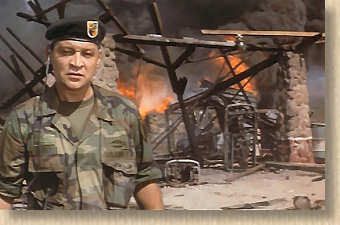
"Universal Solidier" movie still, filmed at Cool Springs in 1991
|
|
| |
|
|
|
|
| |
|
|
|
|
| |
Cool Springs, like the Mother Road that had given it life, refused to fade away. A new interest in Route 66 had begun. People were beginning to tire of the fast-paced generic Interstate and return to the old two-lanes to rediscover America. At first it was a grass-root movement begun by a few dedicated individuals. But soon over time this movement caught on and Route 66 became a worldwide phenomena. As in the old days, the fortunes of the Mother Road directly influenced the life and times of Cool Springs Camp - in this nothing had changed. In the great scheme of things, as Route 66 became the highway America couldn't forget, Cool Springs Camp would not be forgotten long. Cool Springs was poised for a rebirth. |
|
| |
|
|
|
|
| |
|
|
|
|
| |
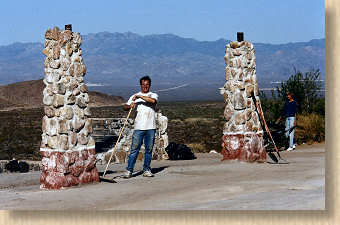
Ned began excavation and cleanup Jan 2002
|
|
In 1997 Ned Leuchtner passed through the area. The beauty, history and majesty of the area intrigued him. When he found the ruins of Cool Springs he couldn’t resist investigating this forgotten relic of a simpler time. He stopped at the site of Cool Springs. His curiosity aroused, Ned wondered what had happened to this place and the people who used to be there. The spirit of the place fascinated and inspired him. |
|
| |
|
|
|
|
| |
Ned contacted his real estate broker, Ben Gangloff of Kingman to find the owners. Ben found the owner Nancy Schoenerr Waverka. Nancy was Floyd Spidell’s niece and the last to live at Cool Springs. Ned Leuchtner tried repeatedly to buy the property for three years from Nancy but to no avail. Nancy’s reasons for not selling were sentimental. Finally, in the summer of 2001, Nancy called and said she wanted to sell. She was moved by Ned’s appeal to rebuild Cool Springs. The rebirth of Cool Springs had begun. |
|
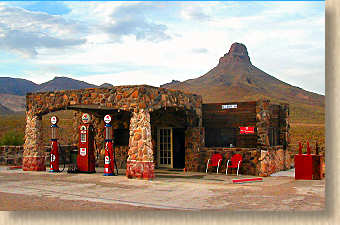
Cool Springs 2004
|
|
| |
|
|
|
|
| |
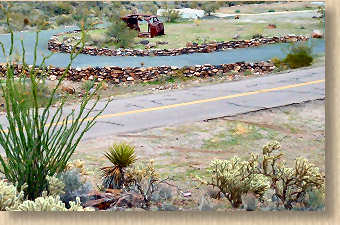
The rusted body of an old Nash at Cool Springs
|
|
In the fall of 2004, Ned Leuchtner and his general contractor and builder Dennis DeChenne, completed the rebuild of the station at Cool Springs. December 7th, 2004 was a banner day for Cool Springs. The power was hooked back up. As Ned puts it, “We had the power hooked up at Cool Springs last night. It marks the first time that the lights were on there since 1966.” |
|
| |
|
|
|
|
| |
After almost 40 years, Cool Springs is now open for business again. It is now presented as a welcomed stop for people to enjoy and cherish. It represents the end of the old era, and the beginning of the new appreciation for the days of the past. The construction will begin January 2005 on the building next to the station. This new building will resemble the old cafe, but the Leuchtner’s are going to make it a museum. They decided not to do food service or gas distribution because of the many regulations. But they will offer soft drinks and snacks. |
|

Cool Springs 2005 ~ there's still much to do.
|
|
| |
|
|
|
|
| |
|
|
Ned, a real estate Broker Manager, has a passion for history and restoration. He has done numerous projects over the past 25 years. Most recently an 1860's house in Whilmette, IL
Cool Springs has been the most rewarding. He acquired the property and remains with his professional partner, Ben Gangloff.
Ned plans to spend portions of the year in the land of fresh air an abundant sun of the Arizona desert on Route 66. The resurrection of Cool Springs Camp is an exciting boon to the Mother Road. Thanks to preservationists like Ned Leuchtner the experience of old Route 66 will live on for future generations to enjoy at Cool Springs. |
|
| |
Ned Leuchtner with Ben Gangloff at Cool Springs |
|
|
|
| |
|
|
|
|
| |
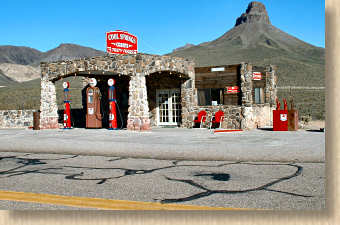
Cool Springs is open for business in 2005!
|
|
| |
|
|
|
|
| |
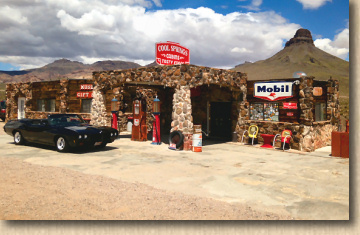
Cool Springs is still going strong in 2018!
|
|
| |
|
|
|
|
| |

Ned & Dennis DeChenne at Cool Springs
|
|
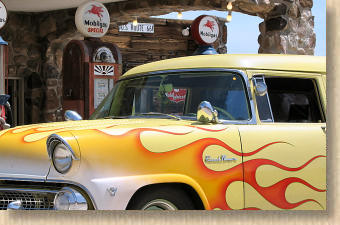
Victorville Car Club shows up at Cool Springs
|
|
| |
|
|
|
|
| |
|
|
|
|
|
|
| |
|
|
|
|
|
© 2003 - Site Design and Hosting by  GRandall Web Design GRandall Web Design
|